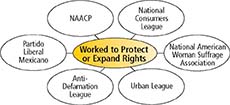CHAPTER 17: Quick Study Guide
Progress Monitoring Online
For: Self-test with vocabulary practice
Web Code: nea-0410
- Effects of Social Progressivism
Living Conditions - Immigrants gain access to child care and English classes.
- Municipal governments are pressured to improve sanitation and tenement safety.
- Minority groups organize, create self-help agencies, and fight discrimination.
- Immigrants are encouraged to become “Americanized.”
- Laws regulate safety of foods and medicine.
Working Conditions - City and state laws improve workplace safety.
- Workers’ compensation laws provide for payments to injured workers.
- Laws limit workday hours; Supreme Court upholds limits for women but not for men.
- State and federal governments were urged to adopt minimum wage and make other reforms.
- Strike fund aids workers who reject unsafe working conditions.
- Minority job seekers gain access to more jobs.
Children - State and federal laws ban child labor; Supreme Court overturns federal ban.
- Compulsory-education laws require children to attend school.
- Poor children gain access to nursery schools and kindergartens.
- Progressive Organizations That Worked for Rights
- Municipal Reforms
Government Reforms Election Reforms - Commission form of government
- City managers
- Trained administrators
- City-owned public utilities
- Direct primary
- Initiative
- Referendum
- Recall
 Quick Study Timeline
Quick Study Timeline
For: Interactive timeline
Web Code: nep-0412






